
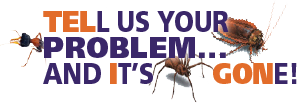
Pests in your home or office are a real nuissance and can be a health hazard. For over 15 years, TELIGON Pest Concepts & Services, LLC has provided effective pest control solutions with 100% guaranteed satisfaction. Within 72 hours of your call, we will perform a thorough inspection to assess and determine the most effective solutions for your pest control problem. Using innovative techniques such as moisture meters, telescoping cameras and UV lights, we identify the source(s) and areas of risk including cracks, leaks and entry points. Upon completion of an initial inspection, we will provide a HUD approved report with our findings and recommendations for effectively addressing your pest problem. Our proactive approach includes continued monitoring to look for new pest activity and to ensure that current treatments are effective.

TELIGON uses innovative, environmentally-friendly solutions to efficiently resolve any pest problem. If there is an infestation, treatment includes the installation of monitoring methods in high-risk areas to keep persistent pests under control and prevent any new problems from arising. Our goal is to target the source of the problem to ensure an effective solution.
With one-time, monthly, quarterly and year-round services, we ensure that once the pests are gone, they stay gone! We are licensed to service the Mid-Atlantic region including: Virginia, West Virginia, District of Columbia (D.C.), Maryland, Delaware and Pennsylvania.
Pest Emergency?
CALL 804-402-8485
Our technicians will respond within 24-Hours
Residential
PEST CONTROL
Comprehensive protection plans for your home.
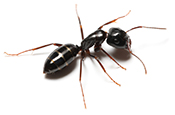 Ants
Ants
 Ants
AntsAnts can enter the premises through the tiniest cracks and crevices looking for moisture and sweet or greasy foods. As they are searching for food, they leave a chemical trail with pheromones that others will follow to locate the food source. Colonies can live up to seven years, number up to 500,000 and can quickly relocate when threatened.
There are a number species of ants. Treating them depends on the type of ant infestation you have. Some solutions may require treatment at the source, others require an ongoing service plan. Proper sanitation will help to keep ants at bay making it harder for them to find food sources.
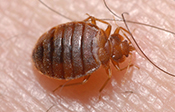 Bed Bugs
Bed Bugs
 Bed Bugs
Bed BugsBed Bugs are small parisitic insects that feed exclusively on blood. They are flat and reddish-brown in appearance about the size of an appleseed, but their bodies bloat after feeding. They are found in cracks and crevices in furniture, mattress seams, behind baseboards and electrical outlets. Often found in hotel rooms, they travel in luggage and other personal belongings. They are more active at night.
The best option for getting rid of bed bugs is to hire a professional. The infestation generally starts in the bedroom close to the host and gradually moves to other rooms throughout the premises. It is recommended that you continue to sleep in your bed by creating a safe zone to limit spreading the infestation. To create a safe zone, strip and vacuum your mattress and boxspring and encase them in a bedbug proof bag. After vacuuming, be sure to discard the bag or tube contents outside. Vacuuming will not rid the are of eggs however. You will still need the help of a professional.
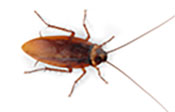 Cockroaches
Cockroaches
 Cockroaches
CockroachesThere are several species of cockroaches with few adaptations; they are social insects and can survive in extremely diverse conditions although the larger species are found more predominantly in tropics and subtropics. Some species invade human dwellings and become pests. The most common indoors is the German Cockroach. The pheromones and chemicals released through glands or fecal matter result in swarm behavior leading to an infestation. They can be carriers of various diseases, emit unpleasant odors and some make sounds.
Cockroaches can enter the premises in various ways – through cracks and crevices, vents, sewage and drain pipes, in luggage, purses, grocery bags, or even on our person. Homes and restaurants are the ideal breeding grounds for these pests because there are plenty of food sources, warmth and water. Primarily nocturnal, if you see them during the day you likely have a severe infestation because they have likely been pushed out due to overcrowding. They are great at hiding and their eggs are naturally protected from most insecticides, so many do-it-yourself remedies simply don't work.
 Fleas
Fleas
 Fleas
FleasAdult fleas are parasitic insects that draw blood from a host. The larvae feed on organic debris in particular the feces of adult fleas. Typical hosts include hairy animals such as dogs, cats, rabbits, mice, squirrels and other animals. They are wingless but can jump far distances. Fleas can transmit a variety of diseases to humans and other animals. Interesting fact: fleas have been used in bioterrorism because they carry the Y. pestis virus associated with the bubonic plague and septicaemia. During WWII infected fleas were dropped on China by the Japanese.
Flea infestations in the home are difficult to control without the help of a professional. The primary signs are an itchy pet that is constantly grooming. Also human hosts will experience itchy bites. The best way to prevent an infestation is to limit the hosts access to the home. Using veterinary approved flea control products along with shampooing and brushing while bathing will dramatically reduce a severe infestation on the pet. Frequent and through vacuuming is helpfu aroud areas that the pet frequents. Be sure to discard of the bag after each cleaning. The use of baking soda or table salt (or a combination) around the home can also be helpful by dehydrating fleas. Fleas do not like high temperatures so running any clothing through the dryer should kill any fleas on clothing. Eggs and larvae do not hatch on the host but in carpet, rugs, bedding or upholstery. After hatching, the larvae enter a cocoon stage and car remain in this stage for months until conditions are right to emerge. Once a host is detected through vibrations, rising levels of carbon dioxide and body heat, the adult flea emerges.
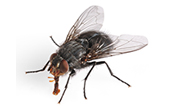 Flies
Flies
 Flies
FliesThere are thousand of species of flies throughout North America and they impact every part of the world except the polar ice caps. All two-winged insects are a part of the fly order including house flies, blow flies, fruit flies and gnats. Flies feed on waste and decomposing organisms. The larvae of certain specie have biomedical uses. Most cary millions of microorganisms on their bodies, legs and in their abdomen that they regurgitate on solid food to liquify the area before reingesting. This behavior leads to the carrying of thousands of pathogens that lead to such diseases as hepatitis, cholera, diarrhea, fever and dysentery. Maintaing sanitary conditions is essential to preventing a fly infestation.
Simple preventive measures can help keep flies away. Most are active from spring to early fall. Limiting access to the premises is the first step to preventing an infestation. Screen vents and keep doors and window screens closed. Garbage cans should be kept clean and closed securely; surfaces should be wiped down. If the problem persists, it is best to call a professional to discuss your options.
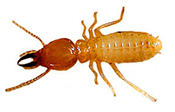 Termites
Termites
 Termites
TermitesKnown as the silent destroyer, termites often invade the premise without any initial signs of damage. Their diet of cellulose-based plant materials make most homes ideal targets, regardless of construction. They feed on parts of living trees including wood, as well as dead trees and plants. Because their mouths are able to tear apart woody material, an infestation may cause a homes foundation to be compromised. Colonies are usually subterranean with tunnel systems that lead to above ground food sources. Mature termites may have wings and can often be found around windows and are most active during the spring.
Termites are a constant threat to your home. Along with professional treatment, their are some small things that can be done to assist your exterminator with controlling the problem. Start by eliminating food sources and moisture around the exterior of the house. Repair any leaking faucets, water pipes and A/C units; keep gutters and downspouts clean, remove any standing water, seal entry points around water and utility lines. Get rid of any stumps or debris near the house and keep firewood away from the foundation. Check to see if there is any damage to your deck or wooden fence.
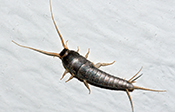 Silverfish
Silverfish
 Silverfish
SilverfishKnown as the silent destroyer, termites often invade the premise without any initial signs of damage. Their diet of cellulose-based plant materials make most homes ideal targets, regardless of construction. They feed on parts of living trees including wood, as well as dead trees and plants. Because their mouths are able to tear apart woody material, an infestation may cause a homes foundation to be compromised. Colonies are usually subterranean with tunnel systems that lead to above ground food sources. Mature termites may have wings and can often be found around windows and are most active during the spring.
Termites are a constant threat to your home. Along with professional treatment, their are some small things that can be done to assist your exterminator with controlling the problem. Start by eliminating food sources and moisture around the exterior of the house. Repair any leaking faucets, water pipes and A/C units; keep gutters and downspouts clean, remove any standing water, seal entry points around water and utility lines. Get rid of any stumps or debris near the house and keep firewood away from the foundation. Check to see if there is any damage to your deck or wooden fence.
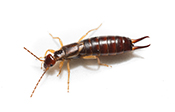 Earwigs
Earwigs
 Earwigs
EarwigsEarwigs have a characteristic pair of forcep-like pinchers on their abdomen that are used for feeding, copulation and defense. The pinchers of males are more rounded than females. They are mostly noctural and often hide in small, dark, moist cracks and crevices during the day. They can be seen on walls and ceilings with they typical behavior of falling and scurrying away to the nearest crevice. During the summer months, they can be found in dark moist areas such as sinks and in bathrooms. Feeding on a wide variety of insects and plants, they are known for damaging crops, flowers and foliage. They can be found living in bark and under fallen logs or large rocks or bolders.
There is a myth that earwigs burrow into the ears of humans. This is mostly untrue, although they may crawl into ears and some can bite but their pincers usually cause little to no harm to humans. There is no evidence that they transmit diseases. They tend to move into homes looking for food or because of a change in weather. The most important aspect of controlling an earwig infestation is eliminating any hiding places. Any professional treatments will do little to help if earwig harboages are not addressed. Move any logs away from the foundation of the house and be sure drain spouts are directing water away from the foundation. An infestation may require a number of chemical treatments.
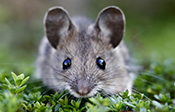 Rodents
Rodents
 Rodents
RodentsRodents are a serious menace to your home and can be difficult to control due to their biology and habitat. Rats will avoid new things added to their environment including rat traps and bait. They tend to colonize in walls, attics, under concrete and porches. Rats can transmit a number of serious diseases and can also introduce disease carrying parasites into the home. Mice invade the home seeking warmth, food and water. They contaminate more food than they eat. Rodents infestations can grown quickly because they are rapid breeders and maintain their populations through constant reproduction. Because of their body structure, rodents are able to squeeze into spaces that appear to be too small for them to fit. All such holes should be sealed to prevent entry. Contact a professional for assistance.
Rodents transmit a number of bacteria, viruses and diseases through their saliva, feces and urine and should never be handled. Signs of a rodent in the home include noticeable droppings around the house and cardboard and other food packages that appear to be nibbled on. Rats and mice feed on seeds and grains and can be very destructive to agricultural communities. They are extremely adaptable animals and can be difficult to exterminate. Professional solutions are often necessary to control the problem.
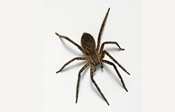 Spiders
Spiders
 Spiders
SpidersMost know these air-breathing arthropods as having eight legs and fangs that inject venom. They are found on most continents except on Antartica and are established in every habitat except air and sea. All but one known species of spider are predators mostly preying on insects and other spiders (a few larger species take on birds and lizards). Using sticky webs is their primary means of capturing prey, they also use lassoing with sticky bolas, mimicking to avoid detection and running down their prey. Females weave slik egg-cases, each of which contains hundreds of eggs. Most spiders live up to two years, some such as tarantulas can live up to 25 years in captivity.
A few species of spider are dangerous to humans, but biomedical and agricultural research is being done on spider venom as a non-polluting pesticide. Spiders will only bite in selfl-defense and few produce serious effects (no worse than a mosquito bite or bee sting). Those bites that lead to serious medical conditions such as recluse and widow spiders, would rather flee and only bite when trapped (although this can arise by accident). The two most dangerous spiders known to man (based on clinical and toxicity grounds) are the funnel web spider and the Brazilian wandering spider. Neither are known to be present in heavily populated areas. Spiders looking for food can easily enter the premises through cracks around the door. A pest control professional can help control an infestation.
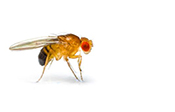 Fruit Flies
Fruit Flies
 Fruit Flies
Fruit FliesThis species of small fly is brown or tan in color. Their populations tend to grow during the summer months but are frequently active throughout the year. They eat fruit, vegetables and fermenting products. Signs of an infestation include adult flies and larvae. They are often seen around trash cans near the decaying food.
The first step in controlling a fruit fly infestation is to destroy their feeding grounds. Throwing out any rotten or over-ripe fruit, emptying the trash and thoroughly cleaning the trash bin. Keep any newly purchased fruit in the refrigerator until the infestation is resolved. Because fruit flies can also nest in clean drains, along with outdoor drains and overripe fruits from trees, total eradication may require several treatlments. Ultimately, the lack of food supply will eventually cause them to die.